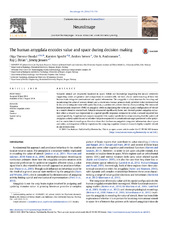The human amygdala encodes value and space during decision making
Ousdal, Olga Therese; Specht, Karsten; Server, Andres; Andreassen, Ole Andreas; Dolan, Ray J.; Jensen, Jimmy Kristian
Peer reviewed, Journal article
Published version
Permanent lenke
https://hdl.handle.net/1956/9515Utgivelsesdato
2014-11-01Metadata
Vis full innførselSamlinger
Originalversjon
https://doi.org/10.1016/j.neuroimage.2014.07.055Sammendrag
Valuable stimuli are invariably localized in space. While our knowledge regarding the neural networks supporting value assignment and comparisons is considerable, we lack a basic understanding of how the human brain integrates motivational and spatial information. The amygdala is a key structure for learning and maintaining the value of sensory stimuli and a recent non-human primate study provided initial evidence that it also acts to integrate value with spatial location, a question we address here in a human setting.We measured haemodynamic responses (fMRI) in amygdala while manipulating the value and spatial configuration of stimuli in a simple stimulus–reward task. Subjects responded significantly faster and showed greater amygdala activation when a reward was dependent on a spatial specific response, compared to when a reward required less spatial specificity. Supplemental analysis supported this spatial specificity by demonstrating that the pattern of amygdala activity varied based on whether subjects responded to a motivational target presented in the ipsilateral or contralateral visual space. Our data show that the human amygdala integrates information about space and value, an integration of likely importance for assigning cognitive resources towards highly valuable stimuli in our environment.

